Theory X and Theory Y Management Styles: Key Differences
If you’re responsible for leading a team within an organization, you may reflect on your management style. A manager can adopt one of two common management styles, which are Theory X and Theory Y. Understanding the difference between these two management styles can help you develop your management skills and lead a team more effectively to meet an organization’s goals.
What is Theory X management?
Theory X is a management style and way of thinking that suggests people work to earn income and support their individual goals. In this management style, managers believe employees need strict guidance and tight supervision regarding assignments. Managers who operate with this mindset supervise their employees closely and rarely involve staff members in decision-making processes or idea generation. Theory X managers believe that employees are inherently lazy and need to be closely monitored and directed to complete their work. They are motivated by rewards or by penalties such as a pat on the back or a kick in the butt.
What is Theory Y management?
Theory Y management suggests that people have the motivation to work because they want to achieve company-wide success and experience personal fulfillment. Theory Y managers believe their employees have unique talents that are valuable to the organization. These managers grant some independence to their employees as they complete their daily tasks and often ask for input regularly when they’re looking to find new methods of completing tasks or solving problems.
How to apply Theory X and Theory Y management styles
It’s important to note that neither Theory X nor Theory Y management is inherently better than the other. The management style you choose to adopt depends on your personal beliefs and the needs of your organization. However, it’s worth noting that companies like Amazon, which are more Theory X types, tend to pay lower wages than Theory Y companies like Costco. If you’re a manager, you should consider working for companies that align better with your perspective.
If you’re interested in learning more about these management styles, you can check out this article from Indeed.com.
Additionally, you can download my free assessment to determine if you are more like a leader or a manager. Leaders tend to be more like Theory Y types, while managers tend to be more like Theory X types. This is because leaders are more focused on inspiring and motivating their team, while managers are more focused on directing and controlling their team.

